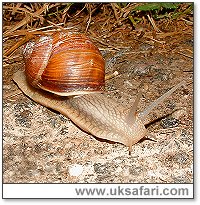
|

|
|
 Sent
to you Sent
to you
by e-mail
|
|
Simply
enter your details and hit the send button
more
info |
|


Click Here

Links
Advertise
Terms of Use
Contributors
About Us
Contact Us
|
 |
Go back
 | Bookmark
| Bookmark
 | Print Page
| Print Page  | E-Mail Us
| E-Mail Us 
 

Photo: G. Bradley
|
|
UK
Safari Tip:
Find out more about land snails of Britain with this neat little book - click
here
|
|
Latin name: Helix pomatia
Size: Shell can be up to 5cms across
Distribution: Rare. Found in southern to central England. The stronghold
for this species is the Downs in Buckinghamshire, England.
Food: Plant matter.
Habitat: Lime rich soils and chalk downland.
Life Span: Up to 10 years
Special features: This is Britain's largest snail, but the lack of
fossil evidence of this species suggests that it may have been introduced. It
was possibly brought here by the Romans as a source of food - hence the name.
 The shell is very rounded, often white in colour with pale brown bands. Here's
one alongside a common garden snail shell. The shell is very rounded, often white in colour with pale brown bands. Here's
one alongside a common garden snail shell.
 Roman
snails mate on damp nights when the weather is cool. Mating can take several
hours. It starts with the male and female circling each other and touching each
others tentacles. Then they raise the front part of their bodies and press their
soles against each other. Roman
snails mate on damp nights when the weather is cool. Mating can take several
hours. It starts with the male and female circling each other and touching each
others tentacles. Then they raise the front part of their bodies and press their
soles against each other.
Roman snails are often referred to as 'Edible Snails', but the common Garden
Snail is just as edible. In any case the Roman Snail is now so rare that it
has legal protection.

UK Safari Creepy-Crawlies Section
|
 |

|